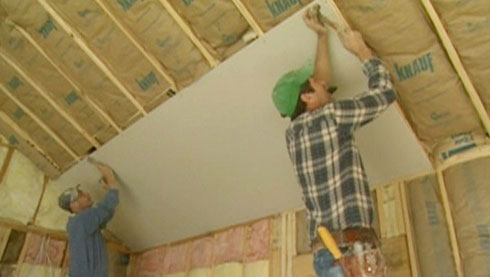Drywall material (which is also referred to as sheetrock, wallboard and plaster board) is a very common, very economical material. It can be installed relatively rapidly compared to plaster and other materials. When your drywall contractor leaves, it is ready for finishing. So what is dry wall composed of? It is a fairly simple material. Drywall (sometimes called: sheetrock, wallboard, plaster board) is a very basic building material which consists of two layers of a special paper material with gypsum sandwiched between it. The reason drywall is called plasterboard in some areas is because a similar material was first used to replace plaster lathe before drywall replaced most plaster wall and ceiling finishes.
By far, the main material in drywall is the mined mineral call gypsum. Gypsum is a very ubiquitous material available as a natural resource throughout most of the world. The origin of the work gypsum is from the word “gypsos,” a Greek term. After gypsum is mined, it is crushed and warmed to remove most of its moisture. The gypsum is easily formed and ideal for the drywall making process.
The paper used for most drywall is typically made from recycled newspaper. Drywall has two sides. One is a face and the other is the drywall backing. The white or off-white front face of the drywall board is smooth and made to receive almost all types of paint. The back of the drywall is made with paper which accepts glues and laminated materials used for various protective applications. The paper can also be made to be moisture-resistant for various applications (such as greenboard drywall used in bathrooms).
The base material in drywall, gypsum, has been used for thousands of years to make plaster materials and plaster of Paris. There are ancient buildings which have plaster dating hundreds and thousands of years which are in usable condition still today. That same material used in drywall has long potential for useful life. Drywall has a relatively high degree of fire resistance because of the high gypsum content.
Here is a brief overview of how drywall is made. Remember drywall is made in various thicknesses and various lengths and widths. Probably the most common drywall is the ½” thick sheets which are 4 feet x 8 feet in size.
Step 1 – The start of wallboard is using the plaster form of gypsum which may contain additives depending on the exact type of drywall being made. The plaster and additives are mixed with water to create a “slurry” which is of a specific consistency to make it formable into drywall.
Step 2 – The slurry of drywall material is mechanically poured onto a layer of paper. The process is highly mechanized and rapidly carried out. As the slurry is being poured on the bottom layer of paper a second layer of paper is applied to the top of what is rapidly becoming a drywall board.
Step 3 – After the drywall (which is being made up to this point in a continuous board) has had its edges bound with a paper edging, it is cut. The lengths (and widths) vary. The most common lengths which drywall is cut is between 8 feet and 16 ft. At some point the size and weight of the boards make it difficult for drywallers and drywall contractors to handle.
Step 4 – The drywall board which has been formed above is next run through a drying furnace with precise temperature controls for roughly 30 to 60 minutes. The purpose is to dry the drywall board to a desired moisture content.
Step 5 – As the drywall is coming out of the drying ovens, it is labeled and inspected, then stacked into loads or drywall lifts which are then ready for shipping to drywall distributors, lumber yards and home centers across the country.

